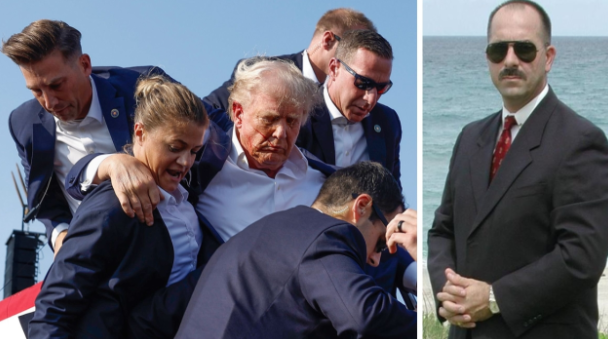Written by Matthew Collins.
In what can only be described as a masterclass in investigative irony, the FBI has recently encountered a baffling conundrum. Imagine this: a man, conveniently perched on a rooftop 150 yards from former President Donald Trump, armed with a gun and attracting considerable attention from nearby onlookers. Yet, despite the conspicuousness of this situation—complete with witnesses and a clear vantage point—the FBI somehow managed to overlook him. The man, calmly preparing for what could only be described as the most elaborate “How to Get Arrested 101” class, went unnoticed while authorities focused on other less obvious pursuits.
One might reasonably assume that the FBI’s resources could easily handle such an obvious threat. After all, this was no covert ninja in the night; this was a guy with a gun on a rooftop, making it a bit challenging to miss. However, the FBI’s apparent inability to locate this man makes one question the efficacy of their surveillance systems. Perhaps the FBI agents were too busy analyzing aerial drone footage of pigeons to notice an armed man practically waving his arms from a rooftop.
While the story of the unobserved rooftop gunman might seem like a punchline, it actually raises unsettling questions about modern law enforcement’s capabilities. If the FBI can’t track a man who’s literally on top of things, what hope is there for more subtle threats? The irony is as thick as the fog over that particular rooftop, leaving us all to wonder: what exactly does it take for the FBI to notice something amiss?
The Curious Case of the Earprint: Arkansas’ Unexpected Infamy
In a dramatic shift from the rooftop fiasco, the FBI has displayed remarkable prowess in a different arena—tracking down a January 6th patriot from Arkansas. The catch? They managed to identify and apprehend this individual based on nothing more than a picture of his ear. Yes, you read that right. The ear—a feature that’s generally considered one of the least distinguishing parts of the human body—became the centerpiece of a high-stakes manhunt.
This scenario not only highlights the bizarre dichotomy of the FBI’s investigative priorities but also underscores the agency’s striking efficiency when it comes to politically charged cases. While a man on a rooftop with a gun was apparently too subtle to track, an ear print from a crowd photo was sufficient to launch a nationwide search. It seems that the FBI’s ability to identify individuals is highly selective, depending on whether or not the case garners enough media attention.
Perhaps this reflects a broader trend in law enforcement: when the stakes are low, so is the attention. But when politics come into play, suddenly every detail becomes crucial. The FBI’s performance in these contrasting cases might be humorous if it weren’t so concerning. As a public, we must wonder whether the true skill of our agencies lies in their ability to find a needle in a haystack or simply to chase the loudest headlines.
The Eccentricity of Modern Law Enforcement
These stories combine to paint a surreal picture of today’s law enforcement landscape. On one hand, we have a rooftop gunman who’s practically begging for attention but remains unnoticed. On the other, an obscure individual is identified and pursued with precision based on a mere earprint. This dissonance not only entertains but also perplexes. It’s as if the FBI is equipped with an extraordinary ability to focus on the minutiae while missing the forest for the trees.
It seems there is an undeniable irony in the fact that one of the most powerful investigative agencies in the world can be so staggeringly ineffective in certain scenarios, yet so astoundingly efficient in others. The FBI’s approach to handling these cases suggests that perhaps their expertise in tracking is influenced more by media buzz than by actual investigative skill.
This strange juxtaposition raises important questions about the criteria used by agencies to prioritize and address security threats. Are we witnessing a selective focus driven by political motivations rather than actual investigative needs? If so, the public should be concerned about the real effectiveness of our law enforcement institutions. The contrasting nature of these cases serves as a reminder of the often surreal reality of modern crime and punishment.
Our Take
The circus of modern law enforcement is both fascinating and frustrating. The FBI’s failure to locate an armed man on a rooftop, juxtaposed with its impressive ability to identify an individual from a single earprint, reveals a troubling pattern. It suggests that investigative priorities might be influenced more by sensationalism and political factors than by effective security measures.
This inconsistency is not just amusing but also deeply unsettling. It reflects a larger issue within the realm of law enforcement: the potential for media and political pressures to dictate the focus and effectiveness of criminal investigations. When the system is more adept at pursuing headlines than at addressing real threats, the public suffers from a skewed sense of safety and justice.
Ultimately, this situation highlights the absurdity and irony inherent in modern law enforcement. As the FBI juggles between missing obvious threats and chasing down obscure leads, the public is left to question the true efficacy of these institutions. It’s a reminder that while headlines may provide momentary amusement, the underlying issues reveal a serious need for reform and a reassessment of priorities.

